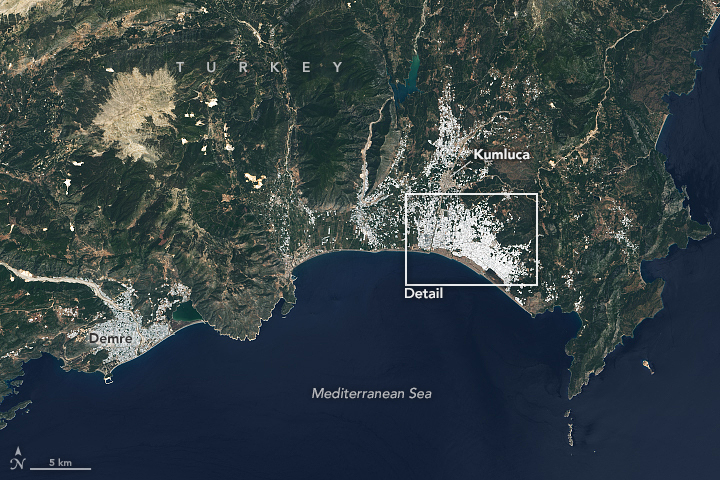

Not So Green Houses
Downloads
- turgreen_oli_2021139_lrg.jpg (5568x5163, JPEG)
- turgreenzm_oli_2021139.jpg (720x480, JPEG)
Metadata
- Sensor(s):
- Landsat 8 - OLI
- Data Date: May 19, 2021
- Visualization Date: March 11, 2022
A University of Kentucky horticulture professor developed the first plastic greenhouse in the 1950s. Plastic greenhouses are an effective and inexpensive way to increase farm yields by extending the growing season and exerting control over temperature and lighting conditions.
The use of plastic on farms has become so common in recent decades that there is a term for it—plasticulture. While there’s still no easy, globally consistent way of tracking how far plasticulture has spread, there are plenty of signs that its footprint is significant. By some estimates, plastic greenhouses now cover as much as 3 percent of China’s farmland. South Korea, Spain, and Turkey also use significant amounts of agricultural plastic for greenhouses.
The transformation of some rural landscapes is on display in these natural-color satellite images of farmland around the Turkish towns of Demre and Kumluca. The Operational Land Imager (OLI) on Landsat 8 observed this part of southwestern Turkey on May 19, 2021. Many of the greenhouses have opaque or translucent plastics that appear white from a distance. Open farmland is generally brown. Forests are dark green.
Tomatoes, peppers, and cucumbers are commonly grown in greenhouses in this area. With 772 square kilometers (298 square miles) of land covered by greenhouses, Turkey ranks fourth in the world in greenhouse cultivation, according to one team of researchers from Çukurova University. That is an area roughly the size of New York City.
Greenhouses aren’t the only way that farmers use plastic. When draped over rows of crops, thin sheets of plastic mulch are often used to protect plants from pests and weeds, as well as reduce the water needed for irrigation. By one estimate, plastic mulches cover as much as 13 percent of China’s farmland, making the country the largest user of agricultural plastic in the world.
While plastics aid crop production, their widespread use by farmers has raised concerns about the environmental impacts and sustainability. Plastics produce toxic air pollution when burned, and they break down into microplastics that often end up in soils and water, according to a 2021 report from the UN Food and Agriculture Organization. The global demand for agricultural plastic is expected to swell in the coming years, increasing from 6.1 million metric tons in 2018 to 9.5 million metric tons by 2030, according to the report authors.
References
- Gündoğdu, R. et al. (2022) Remote Sensing of Agricultural Greenhouses and Plastic-Mulched Farmland: An Analysis of Worldwide Research. Environmental Science and Pollution Research.
- Hortidaily (2018) Greenhouse production in Turkey. Accessed March 11, 2022.
- Jimenez-Lao, R. et al. (2020) Remote Sensing of Agricultural Greenhouses and Plastic-Mulched Farmland: An Analysis of Worldwide Research. Remote Sensing, 12 (16), 2649.
- Treehugger (2021, November 27) What Is Plasticulture, and Is It Sustainable? Overview and Agricultural Impact. Accessed March 11, 2022.
- Videohive (2021) High angle drone aerial view of greenhouse fields of greens plantation in Demre, Turkey. Accessed March 11, 2022.
- U.N. Food and Agriculture Organization (2021) Assessment of agricultural plastics and their sustainability: A call for action. Accessed March 11, 2022.
- Yilmaz, I. et al. (2005) Turkish greenhouse industry: Past, present, and future. New Zealand Journal of Crop and Horticultural Science, 33 (3).
NASA Earth Observatory images by Lauren Dauphin, using Landsat data from the U.S. Geological Survey. Story by Adam Voiland.
This image record originally appeared on the Earth Observatory. Click here to view the full, original record.